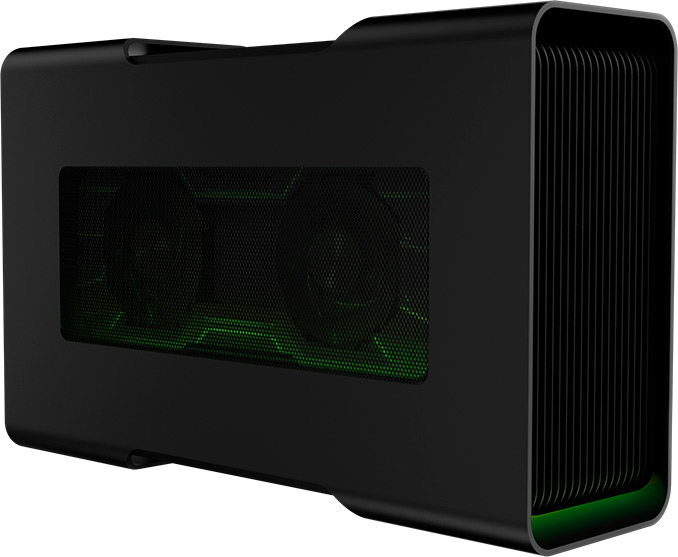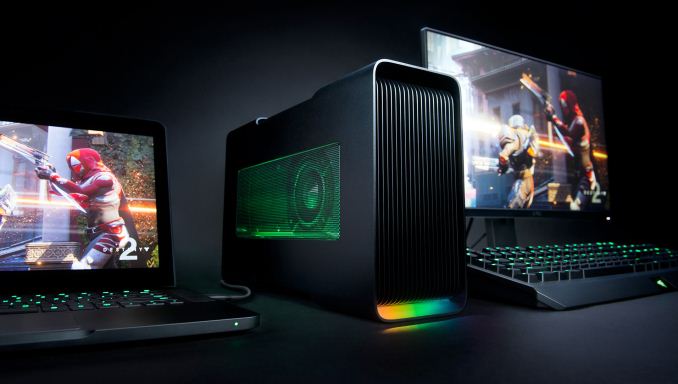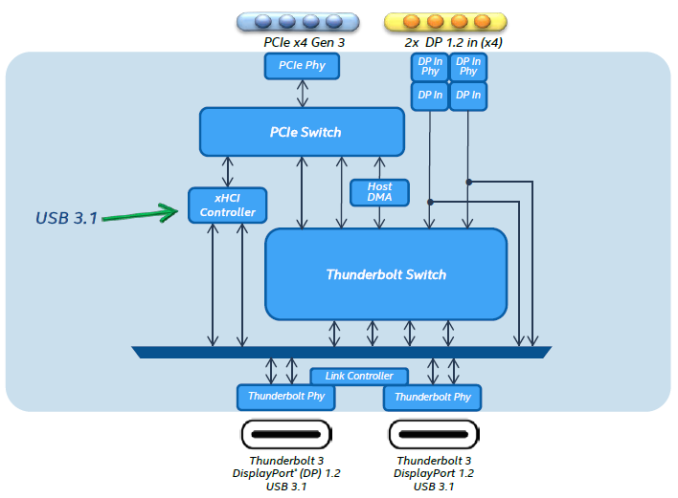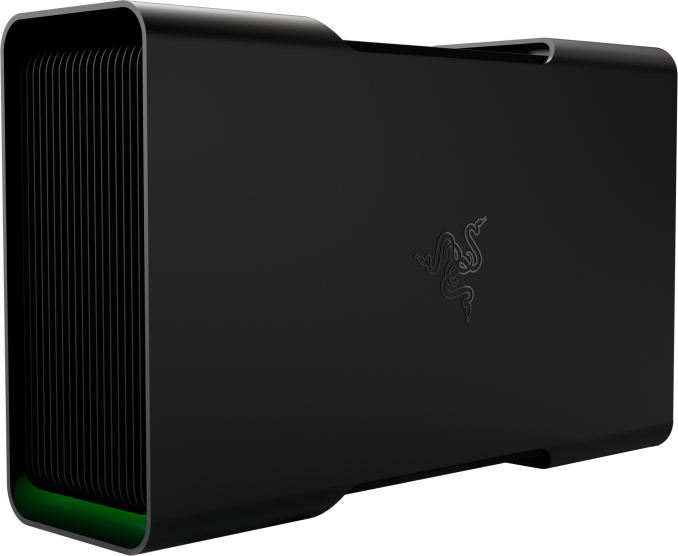Razer Launches Core v2 TB3 eGFX Enclosure: Dual TB3 Controllers
by Anton Shilov on October 31, 2017 3:00 PM EST- Posted in
- GPUs
- External GPU
- Razer
- Thunderbolt 3
- eGFX
- Core V2

Razer has launched a new version of its Thunderbolt 3 external graphics enclosure for video cards, the Core v2. The new Core v2 chassis uses dual Thunderbolt 3 controllers and a USB-C/USB PD controller for easier routing of traffic to/from GPU and other components located in the box. In addition, the Core v2 can support larger graphics adapters than the Core v1, according to the company. As for the price, it remained the same as in the case of the first-gen Razer Core.
The new Razer Core v2 looks exactly the same as the predecessor from the outside: it has the same design, dimensions, two zone RGB Chroma lighting, the same card mounting mechanism, one Thunderbolt 3 input, four USB 3.0 Type-A ports, a GbE connector and so on. Meanwhile, the internal architecture of the Razer Core v2 has been revamped to include two TB3 controllers in order to “ensure fluid gameplay”, as Razer puts it. While two TB3 controllers and one TB3 connector seem a little odd, the two Intel DSL6540 controller chips actually make sense in case of this box.
Every Thunderbolt 3 controller has one or two input/output ports used to connect to external device(s) as well as four PCIe 3.0 x1 input/output lanes to connect to the host and/or to other devices. Each TB3 controller is paired with a USB Type-C and Power Delivery (PD) controller that detects cable orientation, negotiates USB PD, and configures alternate mode settings for internal and external multiplexers, and virtually all eGFX enclosures use Texas Instruments TPS65982 or TPS65983 controllers for this. (The TI controllers are slightly different, with varying Mac compatibility depending on which one is used given macOS does not officially support eGFX at the moment, but this is an entirely different conversation).
In the first generation of the Razer Core the company used one Intel DSL6540 controller coupled with one TI TPS65982 to connect the PCIe GPU slot, a GbE controller, and a USB controller/hub to the external TB3 output (multiplexing all the clients across the PCIe lanes). When all three were used at the same time (when a mouse and a keyboard are plugged to USB Type-A ports and the GbE is used instead of Wi-Fi), they naturally fought for bandwidth and latency, which affected real-world performance, Razer says.
With its second generation Razer Core, the company uses two dual-port Intel DSL6540 ICs coupled with the newer TI TPS65983 controllers. The primary TB3 controller now uses all four PCIe lanes to connect the GPU to the host PC. The secondary TB3 controller is connected to the primary one using the downstream TB3 port of the primary DSL6540 (essentially creating an internal daisy chain) and uses its PCIe lanes for the GbE and the USB controllers (basically, the DSL6540 is used like a PCIe switch). In this scenario, the GPU always gets a priority and the traffic from the other clients is always routed properly. As a bonus, the Core v2 does not have compatibility problems because they now use the newer TI TPS65983 controller.
| Razer Core v2 Thunderbolt 3 eGFX Chassis Specifications | |||
| Max Video Card Size | Double-Wide, 12.2" Long (312 x 145 x 43 mm) |
||
| Max Video Card Power | 375W | ||
| Connectivity | 4x USB 3.0 1x Gigabit Ethernet Laptop Charging via Thunderbolt 3 |
||
| Chassis Size | 4.13 x 13.9 x 8.66 inches (105 x 353 x 220mm) |
||
| Internal PSU | 500W | ||
| System Requirements | Thunderbolt 3 eGFX Certified PC Thunderbolt 3 w/Active Cable Windows 10 |
||
| Compatible Graphics Cads | AMD Radeon RX-series and later NVIDIA GeForce GTX 10-series and later |
||
| Shipping Date | Q4 2017 | ||
| Price | $499 | ||
When it comes to compatibility with video cards, the Razer Core v2 supports all graphics adapters that consume no more than 375 W and have appropriate driver support. Razer claims that the optimized internal designs now allows installation of larger adapters with custom PCBs, but the difference with the v1 is not that significant.*
| Comparison of Thunderbolt 3 eGFX Chassis | ||||||||
| ASUS ROG XG Station 2 | AKiTiO Node |
PowerColor Devil Box |
Razer Core |
Razer Core V2 | ||||
| Chassis Dimensions | Length | 45.6 cm 17.95 in |
42.8 cm 16.85 in |
40 cm 15.748 in |
34 cm 13.38 in |
|||
| Height | 27.8 cm 10.94 in |
22.7 cm 8.94 in |
24.2 cm 9.52 in |
21.84 cm 8.6 in |
||||
| Width | 15.8 cm 6.22 in |
14.5 cm 5.71 in |
17.2 cm 6.77 in |
10.5 cm 4.13 in |
||||
| Max Dimension of Compatible Graphics Card | Length | 31.2 cm 12.2 in |
||||||
| Height (PCB+Cables) |
over 14 cm over 5.51" |
17 cm 6.7 in |
14 cm 5.51 in |
13 cm 5.12 in |
14.5 cm 5.71 in |
|||
| Width | 4.4 cm 1.73 in |
5 cm 1.96 in |
4.3 cm 1.69 in |
|||||
| Maximum GPU Power | 500 W (?) | 300 W (?) | 375 W | |||||
| PSU | Wattage | 600 W | 400 W | 500 W | ||||
| Form-Factor | internal proprietary | SFX | internal proprietary | |||||
| Cooling Fans (mm) | 3 × 80 | 120 | unknown | 3 × 80 | 3 × 80 (?) | |||
| Connectivity | Thunderbolt | 1 × TB3 | 1 × TB3 | 1 × TB3 | ||||
| Ethernet | 1 × GbE | - | 1 × GbE | |||||
| USB | 4 × USB 3.0 1 × USB-B |
- | 4 × USB 3.0 | |||||
| SATA | 1×SATA 6Gb/s | - | 1×SATA 6Gb/s | - | ||||
| DisplayPort | - | - | - | |||||
| Availability | 1/2017 | 12/2016 | 10/2016 | 4/2016 | Q4 2017 | |||
| Price | $? | $299 | $379 | $499 | ||||
Razer intends to ship the Core v2 Thunderbolt 3 eGFX enclosure in the coming weeks in the U.S., U.K., Canada, France, and Germany. The MSRP of one unit for the U.S. market is $499.
*Note that at some point Razer has changed internal specs of the Core v1 compared to the originally declared.
Related Reading
- Razer Core Thunderbolt 3 eGFX Chassis: $499/$399, AMD & NVIDIA, Shipping In April
- Razer’s Blade Stealth 13.3” Laptop Updated With Quad-Core Intel Core i7-8550U CPU
- ZOTAC Readies External GPU Enclosure: TB3, 400 W PSU, Due in Q2 2017
- ASUS ROG XG Station 2 eGFX Enclosure with Thunderbolt 3 Launched
- AKiTiO Introduces Node: Thunderbolt 3 eGFX Box for $299
- PowerColor Announces Devil Box: Thunderbolt 3 eGFX Enclosure
- Razer Updates The Razer Blade Stealth: More Screen, Less Bezel, New Color Option
- Razer Updates The Razer Blade And Razer Blade Stealth At PAX
- The Razer Blade Stealth Review: Razer Takes On The Ultrabook
Source: Razer













20 Comments
View All Comments
nerd1 - Tuesday, October 31, 2017 - link
With $499 one can get decent Case + PSU + MB + CPU... who in right mind will buy this?ATC9001 - Wednesday, November 1, 2017 - link
It's a niche case....if you own a nice portable laptop and don't want to have a gaming desktop and portable laptop but still want to game this is your only option. Not defending the price or sense behind it (I just use portable laptop and have a gaming desktop!) but if money weren't a thing for me and I could have a razer laptop with 1-2TB of SSD storage I might spring for this and have a good keyboard/mouse plugged in.schizoide - Wednesday, November 1, 2017 - link
Yeah, that's the problem in a nutshell.The cool factor of taking a quadcore coffee lake thin/light ultrabook and plugging it into an external enclosure and-- with a single cable-- powering the laptop, getting a bunch of extra USB ports, audio out, ethernet, and an external GPU is substantial, and worth a price premium. But not a FIVE HUNDRED DOLLAR price premium.
Dynamiteboy - Tuesday, November 7, 2017 - link
It's not a cool factor. It clearly meets the need of someone that wants to dock their laptop and have the graphics performance of a desktop. It's very functional.remosito - Wednesday, November 1, 2017 - link
depends on the price of the card, no? Maybe you should go and check how much a 1070 costs and then do some simple mathzodiacfml - Saturday, November 4, 2017 - link
What gaming PC specs can you build from $500?wolfemane - Sunday, November 5, 2017 - link
Dell Optiplex 9020 with an i7-4770 and 16gb Ram can be found for around $200, $250 if you don't have the patience to look around. Can then grab yourself some sata to PCie adapters (unless the Dell PSU has a plug, not sure) and a GTX 1060 6gb card for $250 (cheaper if you buy used). Have yourself a pretty decent little gaming rig, can easily handle 1080p 60fps on some pretty decent graphics settings.If you didn't want to dick around with sata to PCIe power cables and want a faster boot time, you can go with a 1050ti 4gb card for $150 and pick up a 120gb - 240gb SSD for $100.
Dynamiteboy - Tuesday, November 7, 2017 - link
Mmmm good try, but an Optiplex 9020 does not have the power for 1060 Stock and its going to have trouble stuffing the card in there room wise and does not have proper cooling for it.The Razer Core and other E-GPU's price is an early adopter price that fits a niche set of users but it makes perfect sense.
MacScientist - Monday, November 13, 2017 - link
The Node eGFX has Max GPU Power of 375W.MarciaNeill - Sunday, December 8, 2019 - link
It's nice to see your writing, which is exactly what I need, it's very detailedhttp://swordsandsouls.net